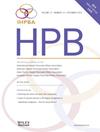机器人胰十二指肠切除术中的虚弱:量化对围手术期结果的影响。
IF 2.4
3区 医学
Q2 GASTROENTEROLOGY & HEPATOLOGY
引用次数: 0
摘要
背景:我们试图确定年龄和虚弱在预测机器人胰十二指肠切除术(RPD)围手术期预后中的意义。方法:对我院前瞻性收集的机器人胰十二指肠切除术数据库中2018-2023年的数据进行分析。采用5因子修正的脆弱性指数(mFI-5)作为评价脆弱性的简明分层工具。采用调整后的logistic回归建立复合不良事件(CAE)变量的预测模型。结果:116例患者行RPD。该队列的平均年龄为70.65岁(±11.44)。平均手术时间311.47 min(±71.35),出血量107.07 mL(±128.49)。CAE中最常见的术后并发症包括胰漏(n = 10, 8.62%)、胃排空延迟(n = 10, 8.62%)、出血(n = 5, 4.31%)和房颤(n = 2, 1.72%)。90天死亡率为1.72%。随着mFI-5评分的增加,CAE的优势比逐渐增加:mFI-5评分为1的比值比为1.52 (95% CI 0.25-9.20), mFI-5评分为4的比值比为31.92 (95% CI 1.79-570.09),而评分为0的比值比为31.92 (95% CI 1.79-570.09)。讨论:术前mFI-5评分可作为rpd的风险分层工具。本文章由计算机程序翻译,如有差异,请以英文原文为准。
Frailty in robotic pancreaticoduodenectomy: quantifying the impact on perioperative outcomes
Background
We sought to determine the significance of age and frailty in predicting peri-operative outcomes of robotic pancreaticoduodenectomy (RPD).
Methods
Data from our institution's prospectively collected robotic pancreaticoduodenectomy database was analyzed for the years 2018–2023. The 5-factor modified frailty index (mFI-5) was used as a concise stratification tool for frailty. Predictive models for composite adverse event (CAE) variable were created using adjusted logistic regressions.
Results
116 patients underwent RPD. Mean age of this cohort was 70.65 years (±11.44). The mean operative time was 311.47 min (±71.35) and the estimated blood loss was 107.07 mL (±128.49). The most common postoperative complications included in the CAE were pancreatic leak (n = 10, 8.62 %), delayed gastric emptying (n = 10, 8.62 %), bleeding (n = 5, 4.31 %), and atrial fibrillation (n = 2, 1.72 %). The 90-day mortality was 1.72 %. There was a gradual increase in the odds ratio of CAE with increasing mFI-5 score: OR 1.52 (95 % CI 0.25–9.20) for mFI-5 score of 1 and OR 31.92 (95 % CI 1.79–570.09) for mFI-5 score of 4 compared to score of 0.
Discussion
Preoperative mFI-5 score may serve as a risk stratification tool for RPDs.
求助全文
通过发布文献求助,成功后即可免费获取论文全文。
去求助
来源期刊

Hpb
GASTROENTEROLOGY & HEPATOLOGY-SURGERY
CiteScore
5.60
自引率
3.40%
发文量
244
审稿时长
57 days
期刊介绍:
HPB is an international forum for clinical, scientific and educational communication.
Twelve issues a year bring the reader leading articles, expert reviews, original articles, images, editorials, and reader correspondence encompassing all aspects of benign and malignant hepatobiliary disease and its management. HPB features relevant aspects of clinical and translational research and practice.
Specific areas of interest include HPB diseases encountered globally by clinical practitioners in this specialist field of gastrointestinal surgery. The journal addresses the challenges faced in the management of cancer involving the liver, biliary system and pancreas. While surgical oncology represents a large part of HPB practice, submission of manuscripts relating to liver and pancreas transplantation, the treatment of benign conditions such as acute and chronic pancreatitis, and those relating to hepatobiliary infection and inflammation are also welcomed. There will be a focus on developing a multidisciplinary approach to diagnosis and treatment with endoscopic and laparoscopic approaches, radiological interventions and surgical techniques being strongly represented. HPB welcomes submission of manuscripts in all these areas and in scientific focused research that has clear clinical relevance to HPB surgical practice.
HPB aims to help its readers - surgeons, physicians, radiologists and basic scientists - to develop their knowledge and practice. HPB will be of interest to specialists involved in the management of hepatobiliary and pancreatic disease however will also inform those working in related fields.
Abstracted and Indexed in:
MEDLINE®
EMBASE
PubMed
Science Citation Index Expanded
Academic Search (EBSCO)
HPB is owned by the International Hepato-Pancreato-Biliary Association (IHPBA) and is also the official Journal of the American Hepato-Pancreato-Biliary Association (AHPBA), the Asian-Pacific Hepato Pancreatic Biliary Association (A-PHPBA) and the European-African Hepato-Pancreatic Biliary Association (E-AHPBA).
 求助内容:
求助内容: 应助结果提醒方式:
应助结果提醒方式:


